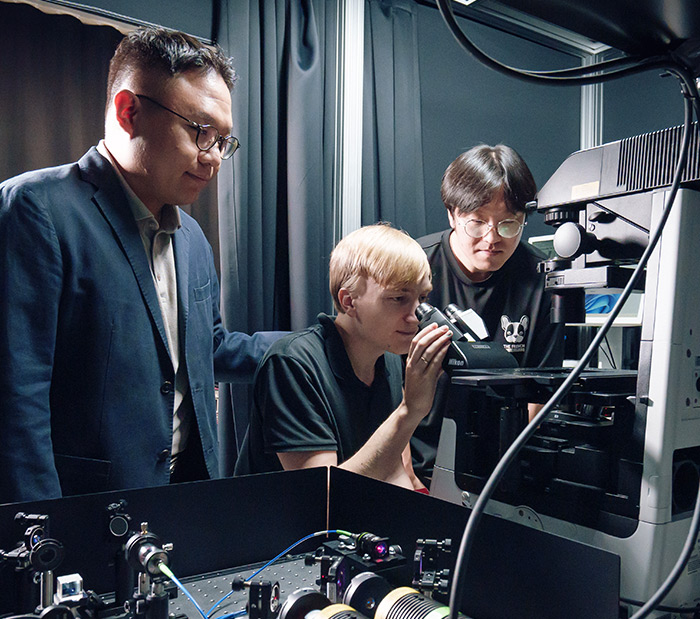Research Stories
Biophysics, Prof. Inki Kim Development of metalens system for single molecule detection in real-time
- Development of ultra-sensitive metalens for observing the movement of a single molecule at room temperature.
- Proposal of a portable single-molecule sensor integrated with smartphone-based microscopy.
Biophysics
Prof.
KIM, INKI
Dr. Aleksandr Barulin
Professor Inki Kim from the Department of Biophysics at Sungkyunkwan University, along with Dr. Aleksandr Barulin, collaborated with Professor Junsuk Rho and doctoral candidates Yeseul Kim and Dong Kyo Oh from the Department of Mechanical Engineering/Chemical Engineering at POSTECH to develop a highly sensitive metalens device capable of real-time observation of single molecule movement at room temperature. Their research was published in the prestigious scientific journal Nature Communications.
Single-molecule detection technology is considered a key technology in the fields of biosensing, chemical analysis, molecular dynamics, DNA sequencing, and precision medicine. One of the most commonly used methods among various techniques for detecting single molecules is Fluorescence Correlation Spectroscopy (FCS). FCS analyzes the correlation function of fluorescent signals emitted from molecules to observe the behavior of each molecule individually. In particular, FCS technology is highly sensitive to the characteristics of the lens. Therefore, most reported FCS technologies to date have used high-resolution, high-magnification, ahcromatic, and expensive objective lenses that are properly corrected for aberrations.
As the demand for on-site infectious disease diagnosis and personalized/precision medicine increases, scientists are making efforts to develop new biomedical devices such as portable biosensors and miniaturized microscopes that can be integrated with smartphones. However, the lack of technology to miniaturize conventional objective lenses has prevented the development of ultra-compact single-molecule diagnostic devices to date.
The research team has developed a highly sensitive metalens device that can observe the movement of single molecules in real-time using a metasurface, which is an ultra-thin flat optical component with a thickness of only 1/1000th of a human hair (Figure 1). For observing single molecules, it is necessary to use a lens with high focusing efficiency and a large numerical aperture, while simultaneously employing aberration corrected high-quality lenses. To meet all these requirements, the research team optimized silicon-based nanostructures and fabricated the device through precise nanofabrication processes. Using the fabricated metalens, the team successfully observed the movement of Alexa 647 single molecules passing through a small space where the focus of light is formed, with a size of 1.6 nm (Figure 2).
Furthermore, the research team implemented a technique through FCS analysis to determine the diffusion rate of molecules and the viscosity of the solution. They also developed a technology to distinguish between particles of different sizes, such as quantum dots and nanoparticles (Figure 3). Through this metalens, the possibility of a portable single-molecule detection system was demonstrated for the first time. In future research, the team aims to integrate the metalens into smartphone microscopes and 3D-printed ultra-compact microscopes to realize portable single-molecule measurement systems. Ultimately, it is expected that an on-chip single-molecule detection sensor combining such metalenses and silicon photonics chips could be developed.
The research findings were formally published in the prestigious scientific journal Nature Communications (IF = 16.6) on January 2nd. This research was conducted through various funding sources including the K-Brain Project, STEAM: The Future Promising Fusion Technology Pioneer, Engineering Research Center (ERC), Regional Leading Research Center (RLRC), Nanoconnect, POSCO-POSTECH-RIST Convergence Research Center for Flat Optics and Metaphotonics (cFOM), and Sejong Science Fellowship Project.
※ Journal: Dual-wavelength metalens enables epi-fluorescence detection from single molecules
▲ Figure 1. Schematic of the single-molecule detection system based on metalens.
▲ Figure 2. Experimental results of Alexa 647 single molecules measured through metalens fluorescence correlation spectroscopy (FCS).
▲ Figure 3. Various single nano-particle discrimination techniques using metalens FCS.

